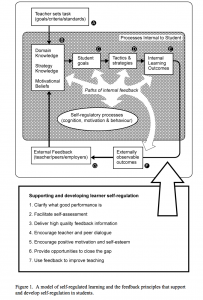This blog posts consists of some notes on a paper titled “The role of informal conversations in developing university teaching?” by Kate Thomson and Keith Trigwell (full reference at end). It ends with reflections from my educational developer perspective. My interest in this topic is tied to a research collaboration with Gary Poole and Roselynn Verwoord.
Thomson and Trigwell’s paper describes how informal “corridor” conversations contribute to the teaching-professional growth of academics. This article is based on a qualitative study of 24 mid-career academics from across six different departments at a research-intensive university in Australia.
Role of informal conversations
The full paper is worth reading, but here I relay only the authors’ findings on the role of conversations. As described in the paper, the roles were:
- “To manage their teaching context (i.e. learning about processes and systems such as library reserves)
- To improve their teaching and student learning
- To reassure themselves about their teaching practice
- To vent about teaching-related issues
- To transform their thinking and practice of teaching” (Thomson & Trigwell, 2016, p.4)
These functions often overlapped with one another. The “manage” role was cited most often by participants, while the “transform” one appeared least often (Figure 2 in the article, presents a nice visual image of the distribution).
Value of informal conversations
- Allow university teachers to deal with challenges related to their teaching, in an manner that is both private and confidential.
- Enable instructors to get reassurance from colleagues about specific teaching issues, and in doing so, promote mutual learning.
- Allow instructors to take a collaborative approach to managing their teaching; this “may mean that issues are resolved quickly and appropriately without academics having to wait for formal opportunities for dialogue” (p.9).
Quick reflections from my educational developer’s perspective: Implications for promoting instructional growth through informal conversations
The authors found that, in some cases, academics took a “problem-solving” approach, rather than a transformative one, because of time constraints. As an educational developer, I have limited control over people’s time. However, when I engage in consulting conversations with faculty members, I can remind myself of the transformative aim if/when I slip into problem-solving mode.
Experienced instructors need support, in particular as they try out new-to-them approaches. I frequently work with experienced instructors and have found this to be true. When designing our teaching and learning centre’s programming, we need to keep this in mind and make sure that sessions are geared, not only at new instructors, but also fulfill the needs of experienced instructors.
As I design professional growth opportunities, I will want to build in opportunities for “reassurance”. Thomson and Trigwell noted that many formal opportunities aim to improve teaching and by-pass the reassurance aspect.
Autonomy with respect to who to talk with, focus, timing, location, and durations of conversations, repeatedly showed up as an important element for fostering conversations in this study. The authors concluded that “It may be this level of autonomy that contributes to the perception of conversations as an effective and efficient way for mid-career academics to learn about teaching” (p.9). As an educational developer, I will continue to encourage academics to speak to other trusted colleagues.
Here is what I’m left with, because it relates directly to one of our research questions: Are there relationships among perceived similarity, value of interactions, and impact of the network on one’s teaching and research on teaching?. Put otherwise: do academics seek out others who they perceive as “similar” to them when they want to engage in conversations? And, do they perceive that conversations with people who share similar beliefs (about teaching and learning) are more valuable?Since “reassurance” figured very prominently in Thomson & Trigwell’s findings, I presume that people do seek out others that are similar to them in their beliefs about teaching and learning. When interacting most often with individuals who share similar beliefs, is the potential for growth and transformation limited? I presume it may be (Roxa and Martenssen, 2009, touch on this too).
“… it is through challenging implicit assumptions and questioning taken-for-granted practices that professional learning can lead to changes in practice.”(Webster-Wright, 2009 p.703)
Thus, the purpose for engaging in the conversation matters. For reassurance, an instructor may seek out like-minded individuals. If they are wanting to growth professionally as a teacher, they may benefit from reaching out to people with diverse approaches to teaching.
You can read my previous posts on significant networks and significant conversations, here. For resources from an ISSoTL (2016) session on the topic, see the Resources section of this site.
References:
Thomson, K.E. & Trigwell, K.R. (2016): The role of informal conversations in developing university teaching?, Studies in Higher Education, DOI:10.1080/03075079.2016.1265498
Webster-Wright, A. (2009). Reframing professional development through understanding authentic professional learning. Review of educational research, 79(2), 702-739.
Photo credit: “Conversation” by fte leaders https: //flic.kr/p/egbSUD




